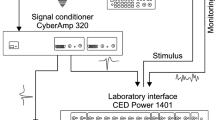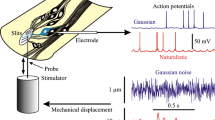Summary
The transfer characteristics of the lyriform slit sense organ HS8 on the leg tibia ofCupiennius salei Keys. (Fig. 1) were investigated by electrophysiological experiments. The organ is made up of 7 slits. It was stimulated by deflecting the metatarsus toward the fixed tibia. The responses of the constituent slits were recorded individually.
-
1.
The step responses of the 2nd to the 4th slits can be described bypower functions (t −k), where (t) is the time and (k) is a constant between 0 and 1 (Figs. 6, 8). This means that the sensilla take a position between a frequency independent system (displacement receptor) and a first order differentiator (velocity receptor). The standard deviations of the receptor responses coincide intra-individually and inter-individually (Fig. 5).
-
2.
Thelinearity of the system was demonstrated using the second slit as an example:
-
a)
The slit responds proportionally to step amplitudes from 0.1° to 0.4°; (k) varies only slightly from 0.32 to 0.38 (Fig. 6).
-
b)
For stimulus frequencies of 0.01 Hz to 8 Hz the transfer functions calculated from the step response and those estimated from sinewave stimulation match well (Fig. 7).
-
c)
For stimulus frequencies of 0.01 Hz to 100 Hz the number of spikes/stimulus sinewave is nearly the same, no matter whether calculated from the step responses or measured by sinewave stimuli (Fig. 12).
-
3.
Comparing the results for the 3 slit sensilla investigated (of a total of 7) the following conclusions are drawn:
-
a)
Thehigh-pass characteristic (exponentk) of the sensilla increases from the 2nd to the 4th slit, while the relative gain decreases (Fig. 8).
-
b)
Thebandwidth of the sensilla decreases according to decreasing sensitivity from slit 2 to slit 4, since the maximal stimulating frequency which can be encoded unequivocally (three spikes/stimulating sinewave) is less than 20–30 Hz for all the slits investigated (Fig. 12).
-
c)
Thefrequency-dependent threshold curves confirm the calculated transfer functions. For a stimulus frequency of 1 Hz the thresholds of the 2nd to the 4th slit are ca. 0.025°, 0.25° and 1.25° (deflection of the metatarsus), at 100 Hz 0.01°, 0.05° and 0.125° (extrapolated). From 0.01 Hz to 100 Hz no tuning of different slits to different “resonant frequencies” was seen (Figs. 11, 12).
-
d)
The characteristic curves (input amplitude vs. output-spike frequency) of the 2nd to 4th slit show an overlap of the amplitude ranges to which the sensilla respond; their linear parts, however, are linked up. This results in an extension of both the effective linear amplitude range and the range of precise detection of amplitude changes. The upper and lower limits of the linear parts of the characteristic curves depend on the stimulus frequency (Figs. 9, 10, 14, Eq. 6).
-
7.
The receptor system can be described as consisting of a linear part with high-pass character plus a nonlinear rectifying part with a threshold. The linear part precedes the nonlinear one (Figs. 15, 16).
Similar content being viewed by others
References
Barth FG (1967) Ein einzelnes Spaltsinnesorgan auf dem Spinnentarsus: seine Erregung in Abhängigkeit von den Parametern des Luftschallreizes. Z Vergl Physiol 55:507–499
Barth FG (1972a) Die Physiologie der Spaltsinnesorgane. 1. Modellversuche zur Rolle des cuticularen Spaltes beim Reiztransport. J Comp Physiol 78:315–336
Barth FG (1972b) Die Physiologie der Spaltsinnesorgane II. Funktionelle Morphologie eines Mechanorezeptors. J Comp Physiol 81:159–186
Barth FG (1976) Sensory information from strains in the exoskeleton. In: Hepburn H (ed) The insect integument. Elsevier, Amsterdam, pp 445–473
Barth FG (1980) Campaniform sensilla: Another vibration receptor in the crab leg. Naturwissenschaften 67:201–202
Barth FG (1981) ‘Strain’ detection in the arthropod exoskeleton. In: Laverack MS, Cosens D (eds) Sense organs. Blackie, Glasgow, pp 112–141
Barth FG, Bohnenberger J (1978) Lyriform slit sense organs: Thresholds and stimulus intensity ranges in a multiunit mechanoreceptor. J Comp Physiol 125:37–43
Barth FG, Libera W (1970) Ein Atlas der Spaltsinnesorgane vonCupiennius salei Keys. Chelicerata (Araneae). Z Morphol Tiere 68:343–368
Barth FG, Pickelmann P (1975) Lyriform slit sense organs in spiders: Modelling an arthropod mechanoreceptor. J Comp Physiol 103:39–54
Barth FG, Seyfarth E-A (1979)Cupiennius salei Keys. (Araneae) in the highlands of central Guatemala. J Arachnol 7:255–263
Bendat JS, Pearsol AG (1966) Measurement and analysis of rando data. John Wiley, New York
Biederman-Thorson M, Thorson J (1971) Dynamics of excitation and inhibition in the light adaptedLimulus eye in situ. J Gen Physiol 58:1–19
Bohnenberger J (1978) The transfer characteristics of a lyriform slit sense organ. Symp Zool Soc (Lond) 42:449–455
Brown MC, Stein RB (1966) Quantitative studies on the slowly adapting stretch receptor of the crayfish. Kybernetik 4:175–185
Chapman KM, Smith RS (1963) A linear transfer function underlying impulse frequency modulation in a cockroach mechanoreceptor. Nature 197:699–700
Chapman KM, Mosinger JL, Duckrow RB (1979) The role of distributed coupling in sensory adaptation in an insect mechanoreceptor. J Comp Physiol 131:1–12
Draŝlar K (1973) Functional properties of trichobothria in the bugPyrrhocoris apertus (L.). J Comp Physiol 84:175–184
French AS, Wong RKS (1976) The response of trochanteral hair plate sensilla in the cockroach to periodic and random displacements. Biol Cybern 22:33–38
French AS, Holden AV, Stein RB (1972) The estimation of the frequency response function of a mechanoreceptor. Kybernetik 11:15–23
Gewecke M, Schlegel P (1970) Die Schwingungen der Antenne und ihre Bedeutung für die Flugsteuerung beiCalliphora erythrocephala. Z Vergl Physiol 67:325–362
Heinzel H-G (1978) Aerodynamische, mechanische und elektrophysiologische Untersuchungen an der Heuschreckenantenne als Luftströmungssinnesorgan. Dissertation, Universität Düsseldorf
Jonsche AK (1977) The ‘universal’ dielectric response. Nature 267:673–679
Liesenfeld FJ (1961) Über Leistung und Sitz des Erschütterungssinnes von Netzspinnen. Biol Zentralbl 80:465–475
Loewe R, Linzen B, Stackelberg W von (1970) Die gelösten Stoffe in der Haemolymphe einer Spinne,Cupiennius salei Keys. Z Vergl Physiol 66:27–34
Mann DW, Chapman KM (1975) Component mechanisms of sensitivity and adaptation in an insect mechanoreceptor. Brain Res 97:331–336
Marko H (1977) Methoden der Systemtheorie. Die Spektraltransformation und ihre Anwendung. Springer, Berlin Heidelberg New York
Merz L (1970) Grundkurs der Regelungstechnik. Oldenbourg, München Wien
Mill PJ, Harris DJ (1977) Observations of the leg receptors ofCiniflo (Araneida: Dictynidae). III. Proprioceptors. J Comp Physiol 119:63–72
Rosenthal NP, McKean TA, Roberts JW, Terzuolo CA (1970) Frequency analysis of the stretch reflex and its subsystems in triceps surae muscles of the cat. J Neurophysiol 33:713–749
Schlegel P (1970) Die Leistungen eines Gelenkrezeptors der Antenne vonCalliphora für die Perception von Luftströmungen. Elektrophysiologische Untersuchungen. Z Vergl Physiol 66:45–77
Schnorbus H (1971) Die subgenualen Sinnesorgane vonPeriplaneta americana: Histologie und Vibrationsschwellen. Z Vergl Physiol 71:14–48
Seyfarth E-A (1978) Lyriform slit sense organs and muscle reflexes in the spider leg. J Comp Physiol 125:45–57
Seyfarth E-A, Barth FG (1972) Compound slit sense organs on the spider leg: Mechanoreceptors involved in kinesthetic orientation. J Comp Physiol 78:176–191
Speck J (1980) Zum Vibrationssinn der Spinnen: Funktionelle Morphologie des Klauenbereiches, Physiologie der Praetarsalspalte. Diplomarbeit, Universität Frankfurt
Tautz J (1978) Reception of medium vibration by thoracal hairs of caterpillars ofBarathra brassicae L. (Lepidoptera, Noctuidae). II. Response characteristics of the sensory cell. J Comp Physiol 125:67–77
Tautz J (1979) Reception of particle oscillation in a medium —an unorthodox sensory capacity. Naturwissenschaften 66:452–461
Thorson J, Biederman-Thorson M (1974) Distributed relaxation processes in sensory adaptation. Science 183:161–172
Varjú D (1977) Systemtheorie für Biologen und Mediziner. Springer. Berlin Heidelberg New York
Wainwright SA, Biggs WD, Currey JD, Gosline JM (1976) Mechanical design in organisms. Unwin Brothers, Woking London
Walcott C, Kloot WG van der (1959) The physiology of the spider vibration receptor. J Exp Zool 141:191–244
Wiese K (1972) Das mechanorezeptorische Beuteortungssystem vonNotonecta I. Die Funktion des tarsalen Scolopidialorgans. J Comp Physiol 78:83–102
Wyse GA (1971) Receptor organisation and function inLimulus chelae. Z Vergl Physiol 73:249–273
Author information
Authors and Affiliations
Additional information
I thank Prof. Dr. F.G. Barth for his continued support and advice during this study. Thanks are also due to Drs. E.-A. Seyfarth and J. Thorson for useful criticisms and to Mr. K. Hammer for technical assistance. Dr. J.S. Rovner kindly helped with the English manuscript. Supported by Grants from the Deutsche Forschungsgemeinschaft (Ba 304/7/9).
Rights and permissions
About this article
Cite this article
Bohnenberger, J. Matched transfer characteristics of single units in a compound slit sense organ. J. Comp. Physiol. 142, 391–402 (1981). https://doi.org/10.1007/BF00605451
Accepted:
Issue Date:
DOI: https://doi.org/10.1007/BF00605451




